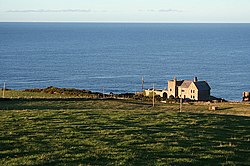Dundarg Castle
| Dundarg Castle | |
|
Aberdeenshire | |
|---|---|
 Remains of Dundarg Castle | |
| Location | |
| Grid reference: | NJ895649 |
| Location: | 57°40’27"N, 2°10’39"W |
| History | |
| Information | |
| Condition: | Ruinous |
Dundarg Castle is a ruined castle in Aberdeenshire, about a mile and a half north of New Aberdour. It was built within the ramparts of an earlier Iron Age promontory fort.[1] Its name comes from the Gaelic dun dearg, meaning red fort or castle, referring to the colour of the sandstone.[2]
This castle was described by W. Douglas Simpson as one of the nine castles of the Knuckle, referring to the rocky headland of north-eastern Aberdeenshire.[3]
The site consists of a triangle of gently sloping ground flanked by steep slopes on all sides, linked to a flat-topped elongated promontory extending to the north-east, surrounded by sandstone cliffs 70 feet high.[2]
History
The 6th century Book of Deer records the existence of a cathair or fortified place at Aberdour.[2]
The castle itself was built in the thirteenth century by the Comyn family, and subsequently dismantled, probably by their deadly rival, Robert the Bruce, in 1308. It was rebuilt in 1334 by Henry de Beaumont, but destroyed almost immediately, after a famous siege by Sir Andrew Moray. Evidence of this double destruction was confirmed by excavations during 1911-12 and in 1950-51, which found many mediæval objects.
The only substantial part of the castle remaining is the inner gatehouse, which survives to a height of about 18 feet. The upper part was rebuilt about the middle of the sixteenth century, probably following the Coastal Defence Commission of 1550, and there is some evidence that it was provided with gunloops at this time. The site was finally abandoned in the mid-17th century. A house was built on part of the site in 1938, reputedly by and for Wing Commander David Vaughan Carnegie, using stone from the former Aberdour Free Church.[4]
The castle and promontory fort are protected as a scheduled monument,[5] while the modern house is a category B listed building.[6]
References
- ↑ Canmore.
- ↑ 2.0 2.1 2.2 Fojut & Love 1983, p. 449.
- ↑ Simpson, W.D. (1949). "Cairnbulg Castle, Aberdeenshire". Proceedings of the Society of Antiquaries of Scotland 83: 32–44. http://archaeologydataservice.ac.uk/archiveDS/archiveDownload?t=arch-352-1/dissemination/pdf/vol_083/83_032_044.pdf.
- ↑ David Vaughan Carnegie: Dictionary of Scottish Architects
- ↑ Dundarg Castle, fort and castle - scheduled monument detail (Historic Environment Scotland)
- ↑ Dundarg Castle (house) (Category B) - Listing detail (Historic Environment Scotland)
- Beveridge, W. (1912). "Excavations at Dundargue Castle". Proceedings of the Society of Antiquaries of Scotland 48: 184–91. http://archaeologydataservice.ac.uk/archiveDS/archiveDownload?t=arch-352-1/dissemination/pdf/vol_048/48_184_194.pdf. Retrieved 2008-10-15.
- Fojut, N.; Love, P. (1983). "The defences of Dundarg Castle, Aberdeenshire". Proceedings of the Society of Antiquaries of Scotland 113: 449–56. http://archaeologydataservice.ac.uk/archiveDS/archiveDownload?t=arch-352-1/dissemination/pdf/vol_113/113_449_456.pdf. Retrieved 2015-10-10.
- Rees, S.E. (1983). "A wooden ard-share from Dundarg, Aberdeenshire, with a note on other wooden plough pieces". Proceedings of the Society of Antiquaries of Scotland 113: 457–63. http://archaeologydataservice.ac.uk/archiveDS/archiveDownload?t=arch-352-1/dissemination/pdf/vol_113/113_457_463.pdf. Retrieved 2008-10-15.
- "Dundarg Castle". Canmore. Historic Environment Scotland. http://canmore.org.uk/site/19958/dundarg-castle.
- Simpson, W. D. (1954) Dundarg Castle. Aberdeen University.
- Simpson, W. D. (1960) 'Dundarg Castle reconsidered', Transactions of the Buchan Field Club 17(4), pp.9-25.
| The Nine Castles of the Knuckle, Aberdeenshire |
|---|
|
Cairnbulg Castle • Dundarg Castle • Inverallochy Castle • Kinnaird Castle • Lonmay Castle • Pitsligo Castle • Pittulie Castle • Castle of Rattray • Winetower |